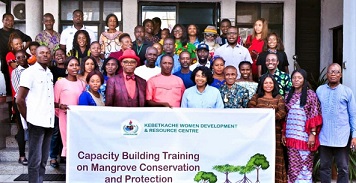By Paul Williams
Mangroves occupy 75 percent of the world’s tropical coast line. Stretching for several kilometres in the Niger Delta, they noticeably serve as one of Nature’s carbon sinks.
This potential for cleansing the Earth and sequestering atmospheric carbon, last Friday in Port Harcourt, became the subject of a capacity building workshop on ‘Mangroves Conservation and Preservation.’
Organised by Kebetkache Women Development and Resource Center, with support from Grassroots International, the training brought together civil society groups, community representatives (from the coastal states in the Niger Delta), members of the academia and media.
According to the executive director of Kebetkache Women Development and Resource Center, Obonganwan (Dr.) Emem Okon, “The Niger Delta is known for pollution. Oil and gas extraction has contributed the most to the pollution of the Niger Delta environment. Rivers are polluted, farmlands, everything else. And now we are directly impacted by climate change manifestations.
“We have been made to understand that forests, such as the mangroves, contribute more to capturing carbon from the atmosphere. They will make our environment cleaner and help address issues of climate change,” she said.
Obonganwan Okon noted that the mangroves had long been a part of the Niger Delta. “We have been engaging with the mangrove since we were born. But we don’t understand the dynamics of the resource that we have, especially at addressing the climate crisis.
“The issue now is, how do we draw back attention to the resource that we have in our local environment, and then make people to understand that we already have the local know-how and can take action to conserve the mangroves because they are already facing threats,” she said.
Such threats to the existence of the mangroves, the national president of the Mangrove Forest Conservation Society of Nigeria (MFCSN), Amasenibo Akie Opuene Hart, PhD., explained in his paper, ‘Benefits, Threats to Mangrove Ecology and Assessment of Current Conservation Programmes,’ include the destruction brought about by oil and gas exploration through seismic operations, “numerous and often uncleared oil spills, gas flares, and companies’ operational routes and canalisation projects.”
Other threats, he said, include “faulty and reckless socio-economic projects that often lack adequate planning and execution without the slightest Environmental Impact Assessment (EIA) studies. Such projects include road construction, reclamation, bridge and canalisation projects, blocking and landfilling of swamps, Creek courses and other mangrove ecology.
“Thirdly, the mangrove ecosystem has come to bear the brunt of abject poverty as experienced in both rural and urban centres. This is because the resources of the mangrove ecology are being increasingly exploited for both home use and commercial transactions. The fourth threat is closely linked with the last and this has to do with the population explosion that in turn exposed the mangrove environment to unhealthy competitive and uncontrolled exploitation, fast degradation and abuse by both natives and visitors. The situation becomes even more precarious when the bulk of the population depends on the mangrove for firewood since they cannot afford alternative petroleum products.”
He also listed the water weed infestation, “where water hyacinths and Nipa palm are clear leaders,” as further threat to the mangrove ecology.
Frowning at the inability of environmental and conservation programmes to adequately preserve the mangrove ecology, Amasenibo Akie Hart called for determined efforts by governments, communities and all stakeholders towards conserving the natural resource.
In a paper titled ‘Mangrove Awareness: A Road Map to Conservation and Preservation,’ environmental consultant, Dr N.L Edwin-Wosu, while stressing their adaptation to the saline environment, Dr Edwin Wosu described mangroves as “an assemblage or community of tropical plant species (of different habit) inhabiting the coaster intertidal zone.”
He noted that mangroves have evolved “special strategy or adaptations to survive intertidal zones with variable flooding and salinity stress conditions imposed by coastal environment,” while further pointing out that “mangroves can also be described as woody, halophytic spermatophytes that occur along low-energy coastlines, deltas, estuaries and embayment through tropics and subtropics.”
Dr Edwin Wosu noted that the global mangrove ecosystem occupies an approximate coverage area of 240,000 km2 of the tropical shorlines, which due to threat from man, invasive species (such as Nypa palm) and other factors, has declined in size.
Nigeria, he said, is among the top 15 most mangrove-rich countries in the world, while the Niger Delta has “the most extensive mangrove forests in the country and situated within a deltaic depositional environment.”
The socio-economic importance of the mangroves, particularly the potential for agricultural revolution, formed a major theme in the lecture, ‘Mangrove Forest Regeneration in the Niger Delta (Mangrove Forest Conservation in Bayelsa and Rivers),’ delivered by the director, Department of Forestry, Rivers State Ministry of Agriculture, Mrs Nkemdirim Odoya.
Noting that conservation does not prohibit the use of a natural resource, Odoya said that the mangrove ecosystem is “endowed with resources which can be utilized for generating sustainable livelihood.”
She stressed their potential for employment creation, revenue generation, coastline protection and conflict resolution, pointing out that Bayelsa and Rivers state forest resources and their utilization hold 33.7% of the 973,000ha of mangrove forests in Nigeria, while Delta State has 20%.
“Global mangrove coastline declined in biodiversity according to FAO (2005) report, from 198000km in 1980 to 146530km in 2000. In Niger Delta, the decline was 2000km2 between 1989-2003.
“The mangrove and swamp of the Niger Delta forest have suffered tremendously from devastation and neglect from unsustainable management, environmental pollution and consequent habitat destruction.
“Firewood and logs harvesting intensifies as unemployment increases. The harvesting and conversion process is exceedingly inefficient and wasteful, causing large scale losses in timber and revenues,” she said.
Michael Zilly Aggrey, executive director of Zadok Foundation, one of the participants at the workshop, commended Kebetkache for being at the forefront of environmental protection and mangrove conservation.
“The training today has given us a better understanding of the importance of our mangrove ecosystem,” he said, adding that “one of the vital ways of sustaining the mangroves is through constant engagement of local communities.
“Taking the message to the grassroots is key. The mangroves are mostly located in the communities and the grassroots, and it is people in these areas that have the first access to them.”
 PH Mundial – Port Harcourt Online Newspaper News Across The Region
PH Mundial – Port Harcourt Online Newspaper News Across The Region





